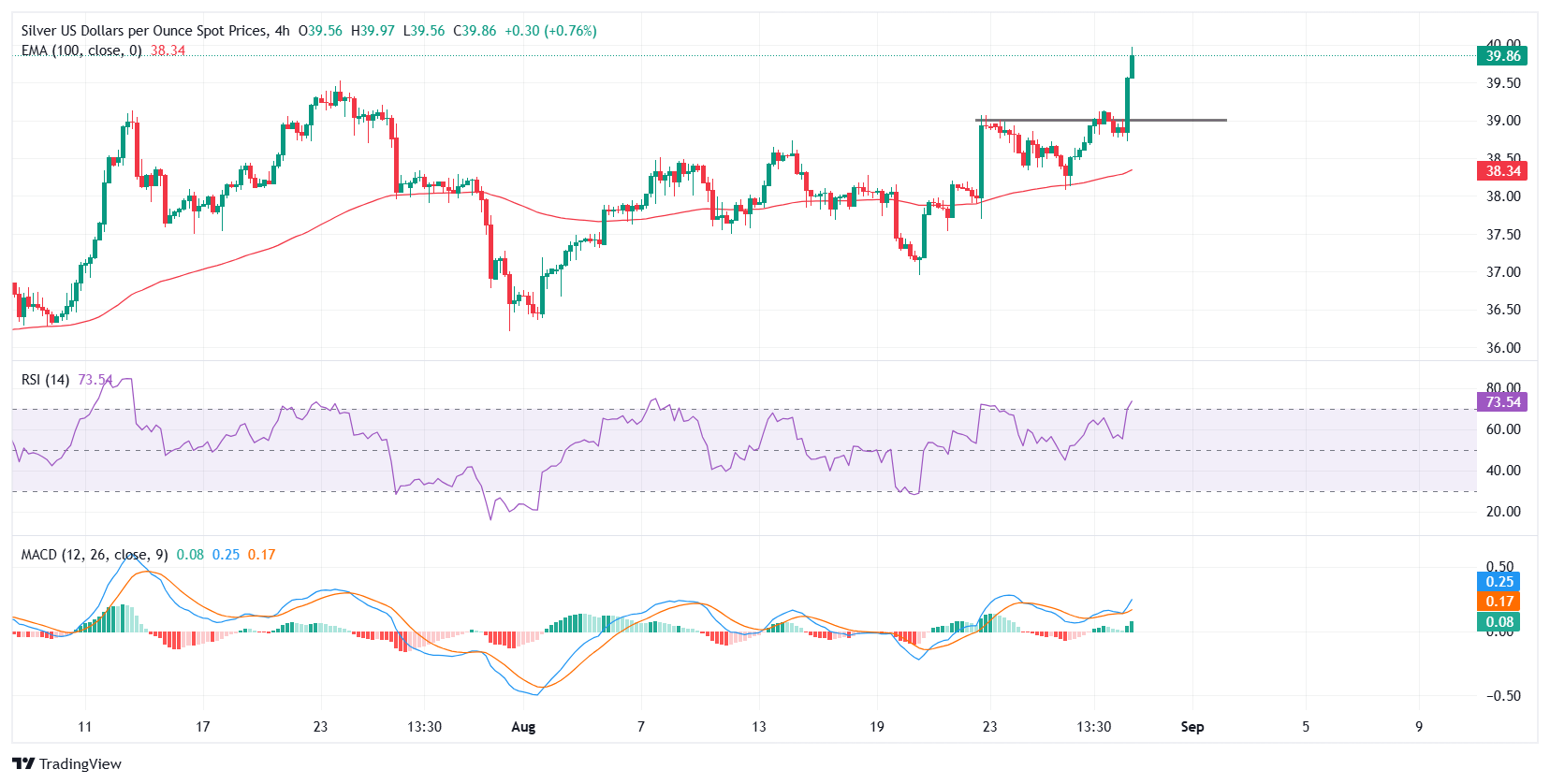Silver Price Forecast: XAG/USD rallies to fresh 14-year high, eyes break above $40.00
- Silver advances to its strongest level since September 2011.
- Markets are pricing about an 87% chance of a Fed rate cut in September, despite firmer core PCE inflation.
- Technical outlook points to a potential break above $40.00, with resistance at $41.48 and $43.40, while support holds at $39.00 and the 100-period EMA.
Silver (XAG/USD) extends its rally for the fourth consecutive day on Friday, with spot prices climbing to fresh 14-year highs. The metal trades around $39.85 at the time of writing, surpassing the July 23 peak of $39.53, as sustained weakness in the US Dollar (USD) and firm safe-haven demand keep buyers firmly in control.
The rally comes as investors continue to bet on an interest rate cut at the Federal Reserve’s (Fed) September monetary policy meeting, even after mixed US inflation data. July’s core Personal Consumption Expenditures (PCE) index rose to 2.9%YoY, its highest in five months, while headline PCE held steady at 2.6%. Although the firmer core reading complicates the policy debate, markets are increasingly focused on the labor market, where signs of cooling hiring momentum and softer wage growth suggest a bigger risk to the economy than lingering inflation pressures.
Swaps are still pricing about an 87% chance of a September cut, keeping the recent dovish tilt in focus. Alongside that, broader factors, including a weaker US Dollar, geopolitical frictions, and steady industrial demand from the solar and green energy sectors, continue to support XAG/USD's bullish momentum.
Adding to the backdrop, concerns over the Fed’s independence have deepened after US President Donald Trump moved to dismiss Fed Governor Lisa Cook on allegations of mortgage fraud. Cook has responded with a lawsuit seeking an injunction to block the decision, marking an unprecedented legal challenge to the central bank’s autonomy. The episode has unsettled confidence in U.S. monetary policy and further pressured the Dollar, reinforcing safe-haven flows into silver. The move has added pressure to an already broadly weak US Dollar and reinforced safe-haven flows into Silver.

From a technical perspective, Silver’s breakout above $39.50 has shifted the near-term bias firmly higher, with the metal now approaching the $40.00 psychological barrier. The 4-hour chart shows XAG/USD comfortably above the 100-period Exponential Moving Average (EMA) at $38.35, while the Relative Strength Index (RSI) sits near 74 in overbought territory, suggesting strong but stretched momentum. A sustained push through this level would open the door toward the $41.48 high from September 12, 2011, with the next upside target at $43.40, the peak from September 5, 2011. On the downside, immediate support lies at $39.00, followed by the 100-period EMA near $38.35, which should act as a key pivot zone for bulls.
Silver FAQs
Silver is a precious metal highly traded among investors. It has been historically used as a store of value and a medium of exchange. Although less popular than Gold, traders may turn to Silver to diversify their investment portfolio, for its intrinsic value or as a potential hedge during high-inflation periods. Investors can buy physical Silver, in coins or in bars, or trade it through vehicles such as Exchange Traded Funds, which track its price on international markets.
Silver prices can move due to a wide range of factors. Geopolitical instability or fears of a deep recession can make Silver price escalate due to its safe-haven status, although to a lesser extent than Gold's. As a yieldless asset, Silver tends to rise with lower interest rates. Its moves also depend on how the US Dollar (USD) behaves as the asset is priced in dollars (XAG/USD). A strong Dollar tends to keep the price of Silver at bay, whereas a weaker Dollar is likely to propel prices up. Other factors such as investment demand, mining supply – Silver is much more abundant than Gold – and recycling rates can also affect prices.
Silver is widely used in industry, particularly in sectors such as electronics or solar energy, as it has one of the highest electric conductivity of all metals – more than Copper and Gold. A surge in demand can increase prices, while a decline tends to lower them. Dynamics in the US, Chinese and Indian economies can also contribute to price swings: for the US and particularly China, their big industrial sectors use Silver in various processes; in India, consumers’ demand for the precious metal for jewellery also plays a key role in setting prices.
Silver prices tend to follow Gold's moves. When Gold prices rise, Silver typically follows suit, as their status as safe-haven assets is similar. The Gold/Silver ratio, which shows the number of ounces of Silver needed to equal the value of one ounce of Gold, may help to determine the relative valuation between both metals. Some investors may consider a high ratio as an indicator that Silver is undervalued, or Gold is overvalued. On the contrary, a low ratio might suggest that Gold is undervalued relative to Silver.

